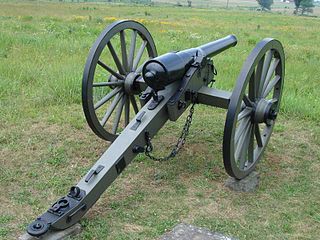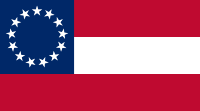
The Army of Northern Virginia was the primary military force of the Confederate States of America in the Eastern Theater of the American Civil War. It was also the primary command structure of the Department of Northern Virginia. It was most often arrayed against the Union Army of the Potomac.

The First Battle of Kernstown was fought on March 23, 1862, in Frederick County and Winchester, Virginia, the opening battle of Confederate Maj. Gen. Thomas J. "Stonewall" Jackson's campaign through the Shenandoah Valley during the American Civil War.
The Battle of McDowell, also known as the Battle of Sitlington's Hill, was fought on May 8, 1862, near McDowell, Virginia, as part of Confederate Major General Stonewall Jackson's 1862 Shenandoah Valley campaign during the American Civil War. After suffering a tactical defeat at the First Battle of Kernstown, Jackson withdrew to the southern Shenandoah Valley. Union forces commanded by Brigadier Generals Robert Milroy and Robert C. Schenck were advancing from what is now West Virginia towards the Shenandoah Valley. After being reinforced by troops commanded by Brigadier General Edward Johnson, Jackson advanced towards Milroy and Schenck's encampment at McDowell. Jackson quickly took the prominent heights of Sitlington's Hill, and Union attempts to recapture the hill failed. The Union forces retreated that night, and Jackson pursued, only to return to McDowell on 13 May. After McDowell, Jackson defeated Union forces at several other battles during his Valley campaign.
The Stonewall Brigade of the Confederate Army during the American Civil War, was a famous combat unit in United States military history. It was trained and first led by General Thomas J. "Stonewall" Jackson, a professor from Virginia Military Institute (VMI). His severe training program and ascetic standards of military discipline turned enthusiastic but raw recruits into an effective military organization, which distinguished itself from the First Battle of Bull Run in 1861 to Spotsylvania Court House in 1864. Its legacy lives on in the 116th Infantry Brigade, which bears the unofficial nickname "Stonewall Brigade," and in several living history reenactment groups.
Richard Brooke Garnett was a career United States Army officer and a Confederate general in the American Civil War. He was court-martialed by Stonewall Jackson for his actions in command of the Stonewall Brigade at the First Battle of Kernstown, and killed during Pickett's Charge at the Battle of Gettysburg.

The Fluvanna Artillery was an artillery battery formed from citizens of Fluvanna County, Virginia, during the American Civil War. It participated in the Antietam and Gettysburg Campaigns, as well as the Shenandoah Valley Campaigns of 1864 under Confederate Major General Jubal Early. The Fluvanna Artillery began as two separate batteries raised in 1861.

Joseph White Latimer, "The Boy Major", was a promising young officer in the Confederate Army of Northern Virginia's artillery branch during the American Civil War. He was mortally wounded at the Battle of Gettysburg and died four weeks later.

The 33rd Virginia Infantry Regiment was an infantry regiment raised in the Commonwealth of Virginia for service in the Confederate States Army during the American Civil War. It was a part of the famed "Stonewall Brigade," named for General Stonewall Jackson.

The Second Corps of the Army of Northern Virginia was a military organization within the Confederate Army of Northern Virginia during much of the American Civil War. It was officially created and named following the Battle of Sharpsburg in 1862, but comprised units in a corps organization for quite some time prior to that. The Second Corps developed a reputation for hard fighting under famed early commander Thomas J. "Stonewall" Jackson.
A. P. Hill's Light Division was an infantry division in General Robert E. Lee's Confederate Army of Northern Virginia during the American Civil War. Originally including six brigades, the division's first commander starting May 27, 1862 was then Major General A. P. Hill. Major Generals William Dorsey Pender and Cadmus M. Wilcox commanded a reorganized Light Division in the Army of Northern Virginia after Hill's promotion to corps command and Pender's death at the Battle of Gettysburg, respectively.
Willis J. Dance (1821-1887) served as a Confederate artillerist in the American Civil War.

The 2nd Virginia Infantry Regiment was an infantry regiment raised in today's western Virginia and what became West Virginia during the American Civil War for service in the Confederate States Army. It would combine with the 4th, 5th, 27th, and 33rd Virginia infantry regiments and the Rockbridge Artillery Battery and fight as part of what became known as the Stonewall Brigade, mostly with the Army of Northern Virginia.

The 4th Virginia Volunteer Infantry Regiment was an infantry regiment raised in southwestern Virginia for service in the Confederate States Army during the American Civil War. It fought in the Stonewall Brigade, mostly with the Army of Northern Virginia. Though it suffered heavy losses, two surviving officers resumed political careers after the conflict and won election to the U.S. House of Representatives, and several more served in the Virginia General Assembly.
The Pee Dee Light Artillery was a distinguished Confederate light artillery battery during the American Civil War. The origins of the battery began as the Darlington Guards, a local militia of Darlington, South Carolina. The Darlington Guards volunteered their service to South Carolina on January 4, 1861, for a period of six months. These men were the very first soldiers to volunteer to fight in Civil War. They became Company B, First South Carolina Volunteers, commanded by Captain F.F. Warley and Lieutenant David Gregg McIntosh. After six months on the Charleston, South Carolina, coast and a short campaign in Virginia, the unit was released. Half the unit remained with Captain Warley and served the remainder of the war as the Darlington Guards. The other half reformed in Darlington, South Carolina, under McIntosh. The unit called themselves the Pee Dee Rifles and in August 1861 rendered their service as an infantry unit to the Confederate States of America for the duration of the war. While in training in Suffolk, Virginia, in the winter of 1861-62, the unit was reorganized as Company D, First South Carolina Regiment, a light artillery battery, and became the Pee Dee Light Artillery.

Battery F, 1st Pennsylvania Light Artillery was a light artillery battery that served in the Union Army as part of the Pennsylvania Reserves infantry division during the American Civil War.

The 58th New York Infantry Regiment, also called the Polish Legion, was an infantry regiment of United States Volunteers in Union Army service during the American Civil War. The regiment was composed almost entirely of immigrant volunteers: Poles, Germans, Danes, Italians, Russians, and Frenchmen, most of whom were recruited in New York City in 1861.
Battery "K" 1st Regiment of Artillery was a light artillery battery that served in the Union Army during the American Civil War.

The 4th U.S. Artillery, Battery E was an artillery battery that served in the Union Army during the American Civil War. The unit fought at the battles of Kernstown, Port Republic, Rappahannock Station, Second Bull Run, Chantilly, Antietam, and Fredericksburg in 1862. The battery transferred to the Cavalry Corps where it served for the rest of the war. In 1863, 4th U.S. Artillery, Battery E fought at Chancellorsville, Gettysburg, Culpeper, Bristoe Station, and Mine Run. In 1864, the unit fought at the Wilderness, Todd's Tavern, Yellow Tavern, Totopotomoy, Cold Harbor, the Wilson-Kautz Raid, Opequon, Fisher's Hill, and Cedar Creek. In 1865, it saw action at Dinwiddie Court House, Five Forks, Sailor's Creek, and Appomattox before taking part in the Grand Review of the Armies.

Independent Battery F, Pennsylvania Light Artillery, also known as the "Pittsburg Battery", was an artillery battery that served in the Union Army during the American Civil War. Organized in December 1861, the unit first served in the Shenandoah Valley. Battery F fought at Hancock, Winchester, Sulphur Springs, Second Bull Run, Chantilly, and Antietam in 1862. The following year the unit fought at Chancellorsville, Gettysburg, the Bristoe Campaign, and Mine Run. In 1864–1865, Battery F fought at Morton's Ford and served in the garrisons of Washington, D.C., and Harper's Ferry, West Virginia before being mustered out in June 1865. One enlisted man from the battery won the Medal of Honor for heroic action at Gettysburg.

The Louisiana Guard Battery was an artillery unit recruited from volunteers in Louisiana that fought in the Confederate States Army during the American Civil War. Formed from an infantry company sent to fight in the Eastern Theater of the American Civil War, it was converted to an artillery company in July 1861. The battery fought at Cedar Mountain, Second Bull Run, Antietam, and Fredericksburg in 1862, and at Chancellorsville, Second Winchester, and Gettysburg in 1863. Most of the soldiers and all of the battery's guns were captured at Rappahannock Station on 7 November 1863. The surviving gunners manned heavy artillery pieces in the defenses of Richmond, Virginia, and the battery's remnant surrendered at Appomattox.


















